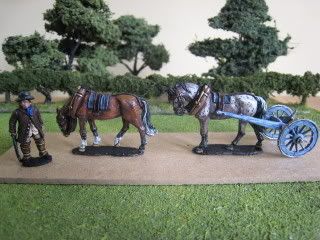
The end is in sight now, so I have chosen the final items that I am going to paint up for the game. The light infantry and most of the grenadiers are finished. Any concern I had about not having the light infantry "doubled up" in both close- and skirmish-order bases has been dispelled by the fact that I, apparently, will be commanding the British light infantry at the game. I intend to use the brigade as elite shock troops, to keep them in close order and try to win the battle all by myself. Consequently, I don't need any lightbobs on skirmish bases...Problem solved. I just have 4 highland grenadiers to finish off and then all the things I had to paint for the game are done.
When I finished the last of the lightbobs last Sunday morning I thought about what I could usefully do for the remaining 2 weeks. Of course a game two weekends hence does not, in fact, give you 2 solid weeks of painting as you have to factor in varnishing and basing, which means that realistically I'm going to have to down tools next Tuesday. So whilst I toyed with the idea of trying to paint one of the 3 British line regiments that I don't as yet have, I rejected it as being too onerous. In any event, it will be good to give the substitute regiments an airing and ultimately A N Other British line battalion is not going to be noticed on the table; better to do something with more visual appeal. So instead, I decided upon a second limber for the British artillery (see the pic above) and having a crack at Smallwood's Marylanders, which was on my original list as something I'd wanted to do. Also, if I have time, there is a pack of Front Rank civilians with spades, picks etc which would be suitable to have working on the Brooklyn fortifications. But the focus will be on the Marylanders, and by using the hunting-shirted North Carolina troops I painted over the summer I only need to paint 12 figures - the command stand in red faced buff coats and some more hatmen in brown shirts and buff breeches. This unit should stand out because I'm going to paint a flag based on Lord Baltimore's coat of arms.

























